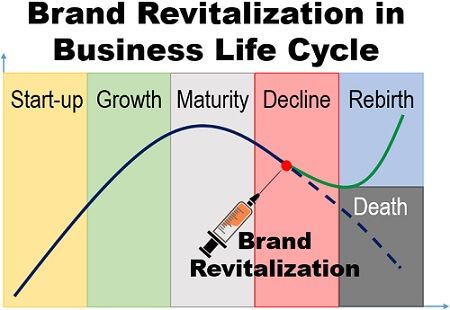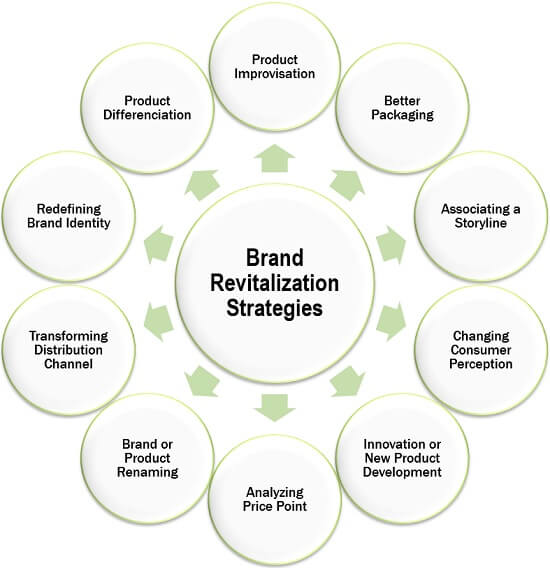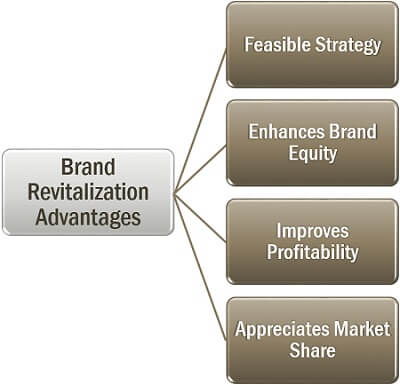Definition: Brand revitalization is a strategical process initiated for improving the existing product, process or brand to meet the changing demands and requirements of the consumers in the evolving market. It is a corrective measure applied when the business or the product is at the maturity or decline stage (alarming phase) of its life cycle and is on the verge of becoming obsolete.
At the decline phase, the company experiences a downfall in the sales, customer turnover, reduced profitability and falling market share. All these symptoms point towards adopting a suitable brand revival strategy.
Content: Brand Revitalization
Brand Revitalization Example
Harley-Davidson Motor Company, USA has one of the best brand revival stories. It is a subsidiary of Harley-Davidson Inc., which is recognized for providing the best quality motorcycles in the world.
In the year 1982, Harley-Davidson was burdened with a debt of $90 million. The business was in havoc due to declining profit and hefty interest payments; even after having a strong consumer base. The company experienced fierce competition from the Japanese companies which were providing a similar quality product at a better price.
At this stage, the company invested money in brand revitalization. The company learned the Japanese quality standards and control strategies to apply it to develop a better engine. This helped the entity to overcome all the quality issue faced by its consumers earlier.
Now, was the turn to reach out to its prospective as well as existing customers. However, the company had a shortage of sufficient funds for advertising. It, therefore, adopted another tactic for promotion.
A ‘Harley Owners Group‘ was introduced for the Harley fans in the year 1983. HOG flourished as a sponsored club initiating community marketing. With this strategy, Harley-Davidson made a grand comeback in the business and is a well-known brand even today.
Reasons for Brand Revitalization
Why do companies go for brand revitalization? Is it just a problem-solving method for the companies?
Brand revitalization is a transformational strategy where the companies aim at overall business growth. To know the various reasons for which reviving of a brand is necessary, read below:
- Globalization: The company need to revive the brand before selling its product in international markets, to make it universally adaptable.
- Technology: With the evolving technology, the companies generate a need for constant upgradation of the brand and the products.
- Competition: In a competitive market, brand revitalization helps to break the stereotype and attract the target audience.
- Reputation: Brand revival becomes necessary to resolve specific issues which harm the company’s goodwill; or unnerves employees or consumers.
- Rationalization: It is a suitable strategy to handle situations like product complexity, cost inefficiency, consumer turnover and dip in profits.
- Pertinence: Brand revival becomes essential when the company no longer serves the purpose of the consumers and tends to go old-fashioned for them.
- Expansion: The company has to go for brand revitalization for fulfilling the requirements of a larger organization while restructuring the business.
- Legal Obligations: It is a vital practice to deal with specific copyright problems like two or more brands having identical names, logos or design for their products.
- Mergers and Acquisitions: A corporate merger requires restructuring and rebranding to please the existing consumers of both companies. Also, in the acquisition, the acquiring company is a dominant player revives the target company’s brand to aim a larger market share.
Brand Revitalization Strategies
Brand revitalization is a result of creative thinking, problem-solving and urge of making improvements. Let us now find out the different strategies which a company may adopt for reviving itself:
Product Improvisation: Any product that is leading the market today, maybe discarded by the buyers tomorrow. Therefore, the company should continuously research and improve product features and usage, to retain its customers.
Better Packaging: If the product looks unappealing to the customer or not available in user-friendly packaging, the chances of rejection increases.
Therefore, another useful strategy is to modify the product packaging such that it serves the customer’s demand competently.
Associating a Storyline: In the present scenario, the product or brand can be backed by a story which relates to the public for creating an impact on the prospective customers.
Changing Consumer Perception: Even an excellent product fails if the consumer remains unaware or misperceives it or the brand. Thus, it becomes essential to develop customer understanding of the company or the product.
Innovation or New Product Development: The most exciting ways of brand revitalization is creatively inventing a new product or process. It will not only increase the consumer base but also beat the competition in the market.
Analyzing Price Point: The company can also rework the product prices according to its value addition, quantity purchased, features, specialization, class and level of customization.
Brand or Product Renaming: If the product or brand name seems to be unpleasant or hurts the sentiments of any community or group of people, thus hampering the sales; it can be revived through a name change.
Transforming Distribution Channel: Some companies expand their business extravagantly, selling to almost everyone. But, through market segmentation company realizes that the target customers are just a handful.
Thus, revitalization of the marketing channel can aid the organization to head its efforts in the direction of the target audience.
Redefining Brand Identity: When the existing customers feel disconnected with the brand and look forward to better options, the company can retain them through value enhancement and better customer experience.
Product Differentiation: This strategy is undoubtedly beneficial in a highly competitive market. Product differentiation is the introduction of some additional features, usage or benefits of the product, which is not yet provided by the competitor.
It helps the brand to become one of its kind and gain attention from the target audience.
Brand Revitalization Advantages
Brand revitalization is the key to present a company like a king in the market. Following are some of its benefits:
- Feasible Strategy: If compared to the failure of a brand (in the decline stage of the business or product life cycle), it is expedient to revive it on time.
- Enhances Brand Equity: The renaissance of a brand can prove to be an efficient tool in attracting and engaging the new consumers.
- Improves Profitability: With an increasing number of loyal and satisfied customers, the company avails the opportunity to generate higher profit than its competitors.
- Appreciates Market Share: The companies which go with the flow of the market and makes constant improvements can secure more significant market share.
Brand Revitalization Disadvantages
Brand revitalization is a hectic task which lacks the certainty of success. Let us now discover other such limitations of this strategy:
- Customer Turnover: The improvisation of the brand or the product, may result in dissatisfaction of some existing customers.
- Resistant to Change: The people associated with the brand, i.e., the employees, customers, shareholders, etc., remain accustomed to the old ways.
- Involves Cost: The designing of the new project as well as the promotion, advertising and marketing of the revived brand or product is an expensive affair.
- Creates Confusion: A revived product or brand may distract the buyers; however, this temporary drawback can be overcome through massive brand awareness programs.
Conclusion
A brand is not just a name but its the identity of the whole company. Brand revitalization brings about a considerable transformation in the way the outer world perceives the company and its products.
Therefore, it must be carefully planned such that the essence of the entity remains intact even though its products are modernized.
Leave a Reply